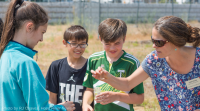An interview with Lorri Epstein, Water Quality Director
Salmon, students, and sampling
An interview with Lorri Epstein, Water Quality Director
Lorri coordinates Columbia Riverkeeper’s water quality monitoring and Nichols Natural Area programs. Prior to joining Riverkeeper, Lorri worked on river restoration issues on the Klamath, Yakima, and Umpqua rivers. She also taught outdoor education in the California Redwoods.
Congratulations on your 10-year anniversary with Riverkeeper! After completing your master’s degree studying salmon in Russia and Canada, what drew you to Riverkeeper?
I explored some of the wildest and most remote salmon rivers in the world through my research. Up to 5 million salmon return every year to the Kol River where I studied in Kamchatka, Russia. I saw firsthand how completely untouched salmon systems functioned, and I was excited to bring that understanding back to rivers like the Columbia. I often thought of the Lewis and Clark quote from when they first saw the Columbia, that you “could walk across the river on the backs of salmon.” I find hope knowing that salmon and rivers are incredibly resilient.
How has Riverkeeper’s water quality monitoring program changed since it started in 2006?
A lot. That’s part of what I love about working for Riverkeeper—we’re dynamic and responsive. We’ve monitored baseline parameters like temperature and pH with hundreds of volunteers, measured toxic contaminants in fish tissue, and checked for bacteria at recreational swimming beaches. What hasn’t changed is constantly asking ourselves, “Where are the gaps?” and “How can we use science to fight for clean water?” We’re always striving to use our data to connect people to the water, and protect and restore a healthy ecosystem.
How can people make informed decisions before swimming in the Columbia River?
Check out the Swim Guide app for our most up-to-date data. According to the U.S. Environmental Protection Agency, an estimated 3.5 million Americans get sick every year from swimming or splashing in water containing harmful bacteria. While many states test beaches, Oregon and Washington do not monitor the Columbia River for bacterial contamination. Riverkeeper fills this void by training volunteers to sample the water and posting real-time results on the Swim Guide app. The app uses E.coli data to flag beaches that are safe or unsafe for swimming. It’s a great tool to check conditions so you can swim with confidence.
Aside from Swim Guide, how does Riverkeeper use water quality monitoring data?
We submit the data to state and federal agencies to help direct pollution reduction and cleanup measures, and to prioritize restoration activities that will create healthy habitats and clean water. Over the years we’ve trained hundreds of volunteers to make regular observations. Our volunteers have identified leaking pipes and prevented oil spills.
What advice do you have for young women interested in a career in environmental science?
Don’t be afraid to get uncomfortable. As a field biologist, I spent months in remote field camps with bugs, grizzly bears (so many bears!), and cold, rainy weather. I was often the only female, and when I first went to Russia I didn’t even speak the language. But I came home with stories to last a lifetime. At Riverkeeper, I’m constantly challenging myself. Learning something new and pushing yourself isn’t supposed to feel comfortable. That’s how we grow. I’m so grateful that our team at Riverkeeper is full of people who inspire, support, and challenge me.
You’ve spoken to thousands of students about the Columbia River. Can you share a favorite story?
The morning of our fall planting party at the Nichols Natural Area we awoke to torrential rain and relentless wind. Ubaldo [Riverkeeper’s Senior Organizer] and I could only laugh at the ridiculous weather and expected no one in their right mind would show up for a tree-planting. Yet there we were—with 85 volunteers! Several parents told me they’d been dragged to the event by their second- or fifth-grader who had visited the site with their class. It ended up being one of my favorite days in the field.
You’ve scoped out dozens of Columbia River beaches over the years. Do you have a favorite?
As a mom to two energetic boys [3 and 6 years old] and a rambunctious herding dog, the number one tool in my parenting toolbox is to “Get. Out. Of. The. House!” We love going to The Spit in Hood River. The dog wears herself out swimming for sticks, and the boys dig channels and dump water in the sand creating their own mini watersheds. It seems everyone in my family breathes a little easier when we’re down by the river.
Any idea how many water quality samples Riverkeeper has taken since the program started in 2006?
Thousands! But I think the most inspiring thing about that number is that each one of those data points is connected to a specific individual. Every measurement we’ve ever collected meant a volunteer taking time out of their life to go to the river, collect a sample, assess the conditions, and report it back to us. When I look at all the data we have collected over the years, I am inspired that so many people care so much.
In this Issue: It’s time to celebrate 20 years of amazing victories for clean water. Each of you makes Columbia Riverkeeper a force for good in these challenging times.



